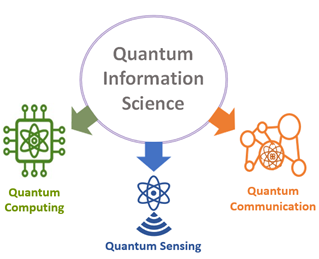
What is quantum information science (QIS)?
Quantum information science (QIS) is an emerging field that harnesses the power of quantum mechanics and information sciences to build innovative technologies including quantum sensors, networks, and computers that are capable of new speed, precision, and functionality.¹
Quantum sensing technologies in particular are gaining importance with several near-term, real-world applications on the horizon in biomedical research.² There are emerging prototype quantum sensors such diamond nitrogen-vacancy (NV) color sensors and optically pumped magnetometers (OPMs), which are shown to have improved accuracy, stability, ultra-sensitivity, and precision and can be operated at reduced costs and power as compared to current methods using classical physics. Entangled photonics-based chip scale sensors are emerging as promising technologies, though are just beginning to be developed. Many of these prototype-stage and emerging sensing technologies have yet to be explored in biomedical use cases. Through further technology development and optimization, these novel sensing technologies can drastically enhance current biological imaging and sensing measurements, which provide unique opportunities and capacities to understand biological phenomena and advance clinical translation, the use of research outcomes in patient care settings.
Quantum computing is another component of QIS. Unlike quantum sensing technologies, quantum computing is a relatively new technology that is in its infancy. Quantum computers have the potential to perform calculations in fundamentally different ways from classical computers and have the potential to solve problems out of reach even of today’s largest supercomputers.³ Current quantum computing advancements focus on the types of quantum processors and in increasing their qubit capacity while reducing the degree of computational errors, which can be addressed using novel quantum error correction methods.⁴ Further research and development in hardware, software, and algorithm development will enable use of quantum computers in a wide range of biomedical data science fields.
How is NIH exploring QIS?
Through ODSS, NIH consults and collaborates with other United States government (USG) agencies to explore opportunities in QIS’ applicable to biomedical domains and the potential for quantum computing for biomedical and data science applications. NIH has established an NIH-wide QIS working group to coordinate the interests and activities in this area within NIH and with other USG agencies.
On January 5, 2023, NIH hosted the NIH Virtual Workshop: Near-term Applications of Quantum Sensing Technologies in Biomedical Sciences. This workshop highlighted several use cases and real-world application of quantum sensing technologies in biomedical research and clinical fields. These include diamond color center sensors, optically pumped magnetometers, quantum photonics and non-classical interferometry, and biosensors. These incredibly accurate and sensitive quantum sensing technologies have potential to improve biomedical imaging, healthcare diagnostics, drug delivery, and novel therapeutics. You can watch the recording here.
NIH collaborated with the Department of Energy’s Advanced Scientific Computing Research (ASCR) program to explore opportunities at the intersection of quantum computing, biomedical research, and data science. This collaboration resulted in the production of a joint report released publicly on December 20, 2023, that identified opportunities and challenges in the near-, medium-, and long-term at the intersection of quantum computing, data science, and biomedical research and detailed how these technical and scientific domains could progress through inter-agency collaboration and multi-disciplinary partnerships.⁵
National Quantum Initiative
The National Quantum Initiative, a coordinated, multi-agency, approach to quantum information sciences, was established in 2018 “to accelerate quantum research and development for the economic and national security of the United States.” The Initiative coordinates national efforts in quantum information science (QIS) research and development and related activities across the United States Federal Government. NIH is engaged to ensure our researchers benefit from these new technologies. That means getting involved early so NIH applications can help to shape the development of new tools and algorithms.
References
¹ https://science.osti.gov/Initiatives/QIS
² https://www.nature.com/articles/s42254-023-00558-3
³ https://www.energy.gov/science/doe-explainsquantum-computing
⁴ https://www.gao.gov/products/gao-22-104422
⁵ https://www.osti.gov/servlets/purl/2228574


